|
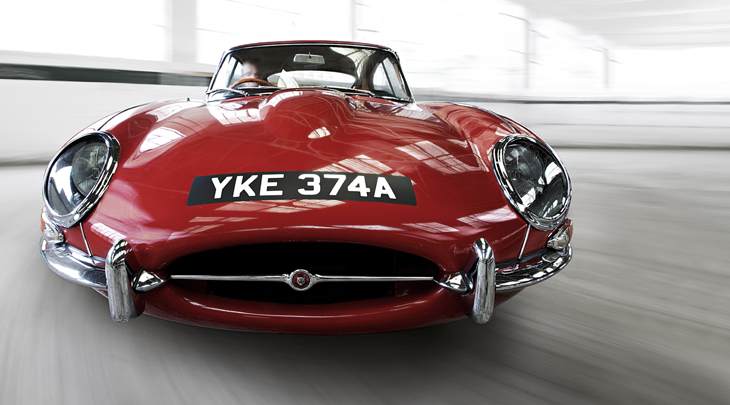
1961 JAGUAR E-TYPE
- 50 YEARS OF ICONIC E-TYPE
2011 marks the 50th anniversary of one of the most famous and desirable cars in automotive history - the Jaguar E-Type. Jaguar will be celebrating this special anniversary year at high-profile motoring events
throughout 2011.
The company will mark the anniversary at the 2011 Geneva Motor Show and go on to celebrate at Goodwood's Revival and Festival of Speed, the Pebble Beach Concours d'Elegance, the Nurburgring Old Timer
Grand Prix and a host of Jaguar customer, dealer and lifestyle events worldwide.
When it was launched in 1961, the appeal of E-Type transcended the automotive world. Such is the inherent
rightness of its proportions, stance and purity of line, that it is a permanent exhibit in New York's Museum of Modern Art.
The now iconic E-Type set new standards in automotive design and performance when it was launched in 1961. Its influence is still apparent in Jaguar's modern range: cars that offer a peerless blend of performance,
comfort, cutting-edge technology and award-winning design.
"Half a century of progress has not diminished the significance of the E-Type," said Mike O'Driscoll, Managing
Director Jaguar Cars and Chairman Jaguar Heritage. "It was a sensation when it was launched, and remains Jaguar's most enduring and iconic symbol. The E-Type is simply one of the most exciting cars ever created
and a legacy to the genius of Jaguar's founder, Sir William Lyons."
E-Type owners included celebrities such as George Best, Brigitte Bardot, Tony Curtis and Steve McQueen
and the sports car became as synonymous with the Swinging Sixties as the Beatles and the mini skirt.
"It is impossible to overstate the impact the E-Type had when it was unveiled in 1961," said Ian Callum,
Jaguar Design Director. "Here was a car that encapsulated the spirit of the revolutionary era it came to symbolise. The E-Type is a design that even today continues to inform the work we do in styling the Jaguars of the future."
Unveiled at the Geneva Motor Show in March 1961, Jaguar's E-Type caused a sensation. Capable of achieving 150mph, but costing a fraction of the price of rivals with similar performance, it was the affordable
supercar and became an instant icon - remaining on sale for 14 years.
E-Type facts
- Manufactured between 1961 and 1975
- The E-Type was presented to the world's press at the restaurant du Parc des Eaux Vives in Geneva on 15th March 1961. Such was the media excitement and clamour for demonstration runs up a nearby
hillclimb that Jaguar founder Sir William Lyons instructed chief test driver Norman Dewis to drive through the night from Coventry to bring another model to Switzerland.
- The E-type's straight-six engine had powered Jaguar to five Le Mans victories in the 1950s and by 1961 in 3.8-litre form produced 265bhp and 260lb ft of torque, making the car a genuine 150mph
proposition and, like its XK120 predecessor, the fastest production car in the world.
- At launch the E-Type cost £2,256 15s, including purchase tax and the all-important optional wire wheels, the equivalent today of just £38,000.
- The E-Type's perfectly proportioned bodywork was the work of Malcolm Sayer, an aeronautical engineer by training who also applied his aerodynamic expertise in shaping the earlier Le Mans-winning
C and D-Type racers.
- The E-type remained in production for 14 years, selling more than 70,000 units, making it Europe's first mass-produced sports car.
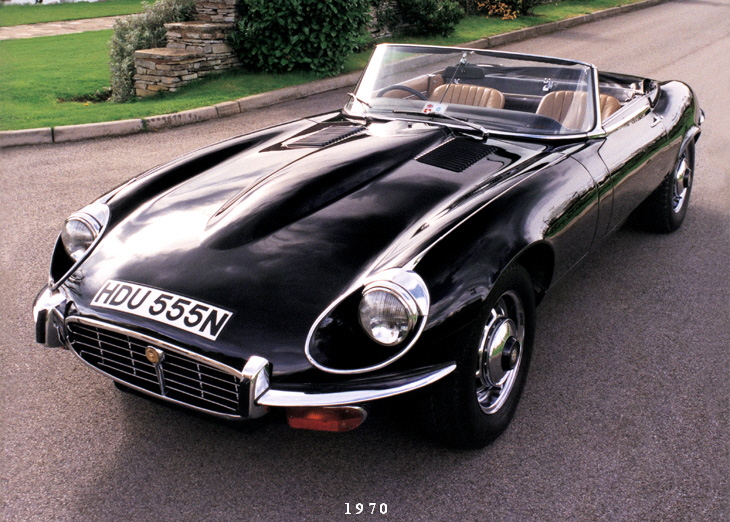

1961 Jaguar E-Type Series I 3.8 Roadster
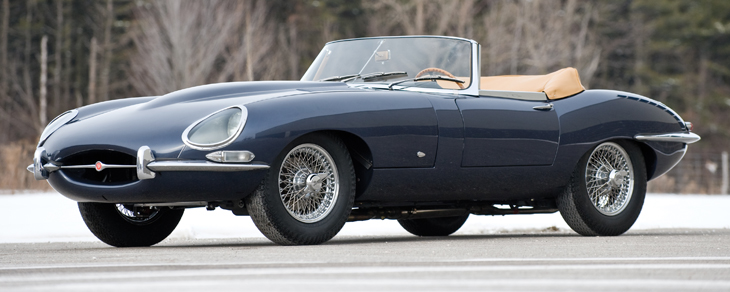

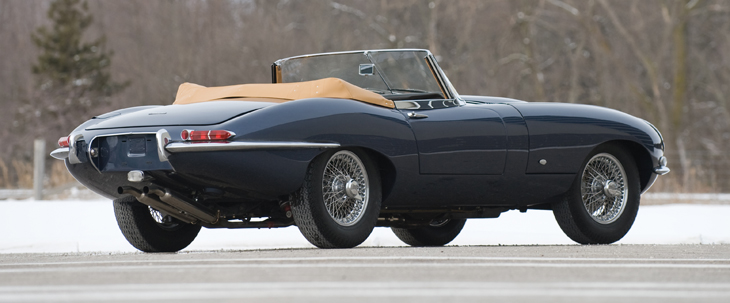

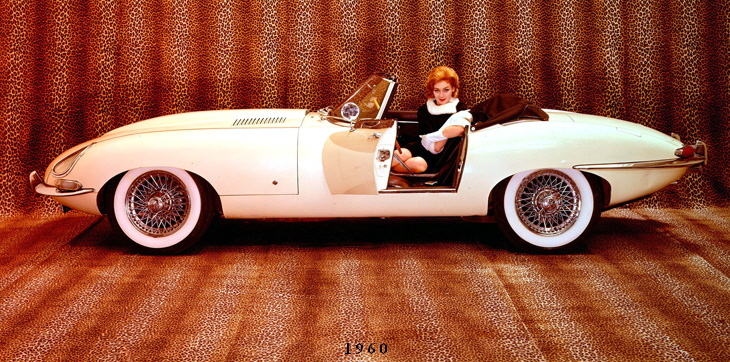
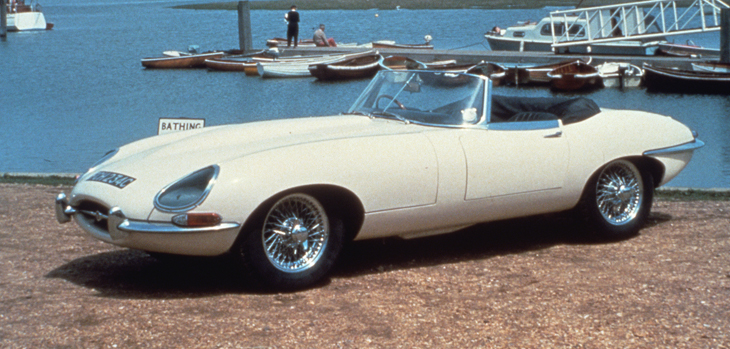

Series 1
The Series 1 was introduced in March 1961. The cars at this time used the triple SU carburetted 3.8 litre 6-cylinder Jaguar XK6 engine from the XK150S. The first 500 cars built had flat floors and external hood
(bonnet) latches. These cars are rare and more valuable. After that, the floors were dished to provide more leg room and the twin hood latches moved to inside the car. The 3.8 litre engine was increased to 4.2 litres
in October 1964.
All E-Types featured independent coil spring rear suspension with torsion bar front ends, and four wheel disc
brakes, in-board at the rear, all were power-assisted. Jaguar was one of the first auto manufacturers to equip cars with disc brakes as standard from the XK150 in 1958. The Series 1 can be recognised by
glass-covered headlights (up to 1967), small "mouth" opening at the front, signal lights and tail-lights above bumpers and exhaust tips under the licence plate in the rear.
3.8 litre cars have leather-upholstered bucket seats, an aluminium-trimmed centre instrument panel and console (changed to vinyl and leather in 1963), and a Moss 4-speed gearbox that lacks synchromesh for 1st
gear ("Moss box"). 4.2 litre cars have more comfortable seats, improved brakes and electrical systems, and an all-synchromesh 4-speed gearbox. 4.2 litre cars also have a badge on the boot proclaiming "Jaguar 4.2
Litre E-Type" (3.8 cars have a simple "Jaguar" badge). Optional extras included chrome spoked wheels and a detachable hard top for the OTS.
A 2+2 version of the coupé was added in 1966. The 2+2 offered the option of an automatic transmission. The body is 9 in (229 mm) longer and the roof angles are different with a more vertical windscreen. (this is
an incorrect assumption, the S1 OTS, coupe and 2+2 had identical rake windshields). The roadster remained a strict two-seater.
Less widely known, right at the end of Series 1 production and prior to the transitional "Series 1½" referred to below, a very small number of Series 1 cars were produced with open headlights. Production dates on
these machines vary but in right hand drive form production has been verified as late as March 1968. The low number of these cars produced make them amongst the rarest of all production E Types.
Following the Series 1 there was a transitional series of cars built in 1967–68, unofficially called "Series 1½", which are externally similar to Series 1 cars. Due to American pressure the new features were open
headlights, different switches, and some de-tuning (with a downgrade of twin Zenith-Stromberg carbs from the original triple SU carbs) for US models. Some Series 1½ cars also have twin cooling fans and adjustable
seat backs. Series 2 features were gradually introduced into the Series 1, creating the unofficial Series 1½ cars, but always with the Series 1 body style.
An open 3.8-litre car, actually the first such production car to be completed, was tested by the British magazine The Motor in 1961 and had a top speed of 149.1 mph (240.0 km/h) and could accelerate from 0-60
mph (97 km/h) in 7.1 seconds. A fuel consumption of 21.3 miles per imperial gallon (13.3 L/100 km; 17.7 mpg-US) was recorded. The test car cost £2097 including taxes.
- Body style(s)
- 2-door coupe,
- 2-door 2+2 coupe,
- 2-door convertible
- Engine(s)
- 3.8 L XK I6
- 4.2 L XK I6
- Transmission(s)
- 4-speed manual,
- 3-speed automatic (1966-onward, 2+2 model only)
- Wheelbase
- 96.0 in (2438 mm) (FHC / OTS)
- 105.0 in (2667 mm) (2+2)
- Length
- 175.3125 in (4453 mm) (FHC / OTS)
- 184.4375 in (4685 mm) (2+2)
- Width 65.25 in (1657 mm) (all)
- Height
- 48.125 in (1222 mm) (FHC)
- 50.125 in (1273 mm) (2+2)
- 46.5 in (1181 mm) (OTS)
- Curb weight
- 2,900 lb (1,315 kg) (FHC)
- 2,770 lb (1,256 kg) (OTS)
- 3,090 lb (1,402 kg) (2+2)
Series 2
Open headlights without glass covers, a wrap-around rear bumper, re-positioned and larger front indicators
and taillights below the bumpers, better cooling aided by an enlarged "mouth" and twin electric fans, and
uprated brakes are hallmarks of Series 2 cars. De-tuned in US, but still with triple SUs in the UK, the engine is easily identified visually by the change from smooth polished cam covers to a more industrial 'ribbed'
appearance. Late Series 1½ cars also had ribbed cam covers. The interior and dashboard were also redesigned, with rocker switches that met U.S health and safety regulations being substituted for toggle
switches. The dashboard switches also lost their symmetrical layout. New seats were fitted, which purists claim lacked the style of the originals but were certainly more comfortable. Air conditioning and power
steering were available as factory options.
- Body style(s)
- 2-door coupe
- 2-door 2+2 coupe
- 2-door convertible
- Engine(s) 4.2 L XK I6
- Curb weight
- 3,018 lb (1,369 kg) (FHC)
- 2,750 lb (1,247 kg) (OTS)
- 3,090 lb (1,402 kg) (2+2)
Series 3
A new 5.3 L 12-cylinder Jaguar V12 engine was introduced, with uprated brakes and standard power steering. The short wheelbase FHC body style was discontinued and the V12 was available only as a
convertible and 2+2 coupé. The convertible used the longer-wheelbase 2+2 floorplan. It is easily identifiable by the large cross-slatted front grille, flared wheel arches and a badge on the rear that proclaims it to be a
V12. There were also a very limited number of 4.2 litre six-cylinder Series 3 E-Types built. These were featured in the initial sales literature. It is believed these are the rarest of all E-Types of any remaining.
- Body style(s)
- 2-door 2+2 coupe
- 2-door convertible
- Engine(s) 5.3 L Jaguar V12
- Wheelbase 105 in (2667 mm) (both)
- Length
- 184.4 in (4684 mm) (2+2)
- 184.5 in (4686 mm) (OTS)
- Width
- 66.0 in (1676 mm) (2+2)
- 66.1 in (1679 mm) (OTS)
- Height
- 48.9 in (1242 mm) (2+2)
- 48.1 in (1222 mm) (OTS)
- Curb weight
- 3,361 lb (1,525 kg) (2+2)
- 3,380 lb (1,533 kg) (OTS)
see Rare Video and Photo Gallery of the JAGUAR E-TYPE
in our Jaguar Image pape
|









